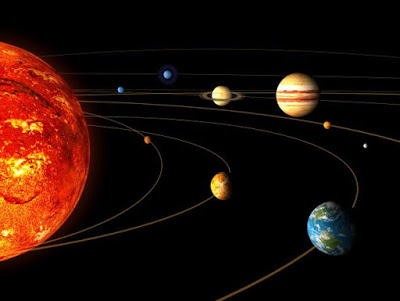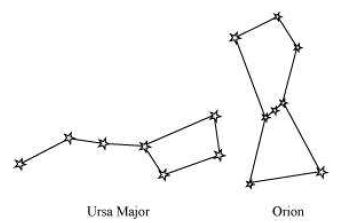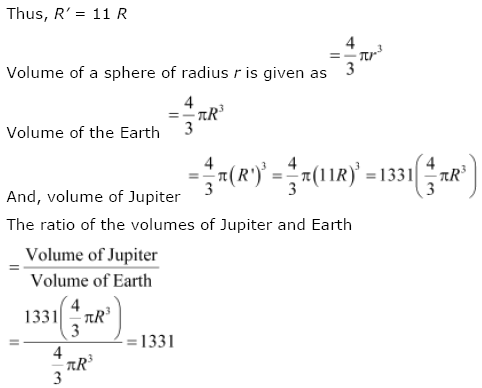
Exercise
1) Which of the following is NOT a member of the solar system?
(a) An asteroid
(b) A satellite
(c) A constellation
(d) A comet
ANSWER 🙁c)
Constellation
Constellation
2) Which of the following is NOT a planet of the sun?
(a) Sirius
(b) Mercury
(c) Saturn
(d) Earth
ANSWER 🙁a) Sirius
3) Phases of the moon
occur because
occur because
(a) We can see only that
part of the moon which reflects light towards us.
part of the moon which reflects light towards us.
(b) Our distance from
the moon keeps changing.
the moon keeps changing.
(c) The shadow of the
Earth covers only a part of the moon’s surface.
Earth covers only a part of the moon’s surface.
(d) The thickness of the
moon’s atmosphere is not constant.
moon’s atmosphere is not constant.
ANSWER:-(a) Phases of the moon occur because we can see only that part of
the moon which reflects light towards us.
the moon which reflects light towards us.
4) Fill in the blanks:
(a) The planet which is farthest from the sun is __Neptune__.
(b) The planet which appears reddish in colour is __Mars__.
(c) A group of stars that appear to form a pattern in the sky is
known as a __constellation__.
known as a __constellation__.
(d) A celestial body that revolves around a planet is known as a
satellite_.
satellite_.
(e) Shooting stars are actually not stars __.
(f)Asteroids are found between the orbits of __Mars __ and
__Jupiter.
__Jupiter.
5) Mark the following
statement as true (T) or false (F).
statement as true (T) or false (F).
(a) Pole star is a
member of the solar system. ( )
member of the solar system. ( )
(b) Mercury is the
smallest planet of the solar system. ( )
smallest planet of the solar system. ( )
(c) Uranus is the
farthest planet in the solar system. ( )
farthest planet in the solar system. ( )
(d) INSAT is an
artificial satellite. ( )
artificial satellite. ( )
(e) There are nine
planets in the solar system. ( )
planets in the solar system. ( )
(f) Constellation Orion
can be seen only with a telescope. ( )
can be seen only with a telescope. ( )
ANSWER:-(a)
False
False
(b) True
(c) False
(d) True
(e) False
(f)False
7) In which part of the
sky can you find Venus if it is visible as an evening star?
sky can you find Venus if it is visible as an evening star?
ANSWER:-the
western sky
western sky
8) Name the largest planet of the solar system.
ANSWER:-The
largest planet of the solar system is Jupiter.
largest planet of the solar system is Jupiter.
9) What is a
constellation? Name any two constellations.
constellation? Name any two constellations.
ANSWER:-A constellation is a group of stars that form a
recognisable pattern in the sky. The two well known
constellations are Ursa Major and Orion.
recognisable pattern in the sky. The two well known
constellations are Ursa Major and Orion.
10) Draw sketches to
show the relative position of prominent stars in (a) Ursa Major and (b) Orion
show the relative position of prominent stars in (a) Ursa Major and (b) Orion
ANSWER:-

11) Name two objects
other than planets which are members of the solar system.
other than planets which are members of the solar system.
ANSWER:-(i)
Asteroids
Asteroids
(ii) Meteors
12) Explain how you can
locate the Pole Star with the help of Ursa Major.
locate the Pole Star with the help of Ursa Major.
ANSWER:-In order to locate the Pole star in the sky, first of all Ursa
Major or Big Dipper constellation
must be located. The bowl of the Big Dipper consists of four bright stars. Consider
two stars at the end of this bowl. Now, draw an imaginary straight line towards
the Northern direction connecting these two stars. This imaginary line meets a
star called the Pole Star. The length of the imaginary line from the bowl is
about five times the distance between the two
stars of the bowl.
Major or Big Dipper constellation
must be located. The bowl of the Big Dipper consists of four bright stars. Consider
two stars at the end of this bowl. Now, draw an imaginary straight line towards
the Northern direction connecting these two stars. This imaginary line meets a
star called the Pole Star. The length of the imaginary line from the bowl is
about five times the distance between the two
stars of the bowl.
13) Do all the stars in
the sky move? Explain.
the sky move? Explain.
ANSWER:-No. The Earth rotates from West to East on its axis. Hence, all
stars in the sky (except the Pole star) appear to move from East to West.
stars in the sky (except the Pole star) appear to move from East to West.
14) Why is the distance
between stars expressed in light years? What do you understand by the statement
that a star is eight light years away from the Earth?
between stars expressed in light years? What do you understand by the statement
that a star is eight light years away from the Earth?
ANSWER:-One light year is equal to 9.46 × 1012 km.
A star is located eight light years away from the
Earth. This means that the distance between the star
and the Earth is equivalent to the distance travelled by light in eight years,
i.e., a star is located 8 × (9.46 × 1012) = 7.6 × 1013 km away from the Earth.
A star is located eight light years away from the
Earth. This means that the distance between the star
and the Earth is equivalent to the distance travelled by light in eight years,
i.e., a star is located 8 × (9.46 × 1012) = 7.6 × 1013 km away from the Earth.
15) The radius of
Jupiter is 11 times the radius of the Earth. Calculate the ratio of the volumes
of Jupiter and the Earth. How many Earths can Jupiter accommodate?
Jupiter is 11 times the radius of the Earth. Calculate the ratio of the volumes
of Jupiter and the Earth. How many Earths can Jupiter accommodate?
ANSWER:-Earth and Jupiter can be considered as two spheres with radii R
and R’ respectively. Given
that the radius of Jupiter is 11 times the radius of the Earth.
and R’ respectively. Given
that the radius of Jupiter is 11 times the radius of the Earth.

16)Boojho made the
following sketch (Fig. 17.29) of the solar system. Is the sketch correct? If
not, correct it (refer to the book)
following sketch (Fig. 17.29) of the solar system. Is the sketch correct? If
not, correct it (refer to the book)
ANSWER:-
Planets of the solar system in sequence of their distances from
the sun are: Mercury, Venus, Earth, Mars, Jupiter, Saturn, Uranus, and Neptune.
Therefore, Boojho’s sketch of the solar system
is not correct because he has interchanged the positions of Mars and Venus and
also the positions of Uranus and Neptune. Also,
he has shown the Asteroid belt in the gap between the orbits of Jupiter and
Saturn. This is not correct.
the sun are: Mercury, Venus, Earth, Mars, Jupiter, Saturn, Uranus, and Neptune.
Therefore, Boojho’s sketch of the solar system
is not correct because he has interchanged the positions of Mars and Venus and
also the positions of Uranus and Neptune. Also,
he has shown the Asteroid belt in the gap between the orbits of Jupiter and
Saturn. This is not correct.